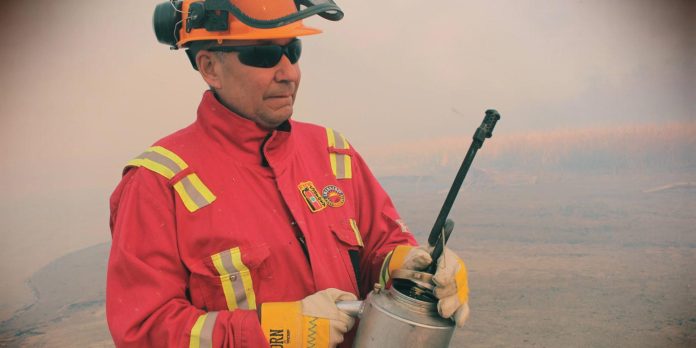The Prince Albert Grand Council (PAGC) is receiving national support for its work using cultural burning for wildfire mitigation and habitat restoration.
The We Are Fire project was developed from the broader muskrats to moose initiative. An exhibit at Prince Albert’s On The Avenue Artisans Gallery in August showcased field camps at the Saskatchewan River Delta to teach others about Indigenous-led fire practices.
“Our Indigenous people, that’s a practice they want to continue to do,” said Cliff Buettner, PAGC director of forestry and emergency protective services.
“Regulations and policy I think have restricted it somewhat, so there’s been kind of a lull in the action over a period of time. We’re trying to revitalize the idea of using fire as a habitat restoration tool.”
For example, Buettner explained, burning invasive Phragmites allows other plants to grow that muskrats will eat, such as calamus root and cattails.
For mitigation of wildfires, Buettner said crews will thin trees surrounding Indigenous communities that would fuel a wildfire.
Buettner has been advocating for burning in the Saskatchewan River Delta since 2005 on a moose management committee. According to the We Are Fire website, the practice enhances habitats of cultural keystone species like moose, fish and birds.
The delta provides a critical habitat for about 500,000 birds to breed and raise their young – a large number for the area of land.
“If I look at Solomon Carriere, a guy that lives there and grew up there, he said ‘I was never taught to fight fire, I was taught to light fire.’ His knowledge of the land and knowing when to burn is important,” said Buettner.
Rather than starting prescribed fires through the province’s permitting system, cultural burning listens to the land.
“What this has done has allowed us to use that traditional knowledge to burn past that date, where it’s not a calendar date, it’s the conditions on the land, what they see.”
The opening of the exhibit in mid-August saw an announcement from a federal minister.
Jonathan Wilkinson, minister of energy and natural resources, announced nearly $525,000 in funding for a two-year pilot program in partnership with the PAGC.
“The Indigenous Wildfire Stewards Pilot program will increase capacity to prepare for and respond to wildfires through training and traditional ecological knowledge,” said Wilkinson in a news release.
“This means providing people with the skills needed to identify and fight wildfires in their communities.”
Parks Canada, Prince Albert Model Forest and the PAGC have also invested in the project.
“Overall, the pilot project underscores the indispensable role the First Nations play in safeguarding our communities, ancestral lands and Inherent and Treaty rights, particularly in the face of climate change,” added PAGC Grand-Chief Brian Hardlotte.
Buettner said after the We Are Fire website launched, members presented at a Firesmart conference in British Columbia. Most recently, they were accepted to present at a conference in California in December.
jayda.taylor@paherald.sk.ca @JournalistJayda


